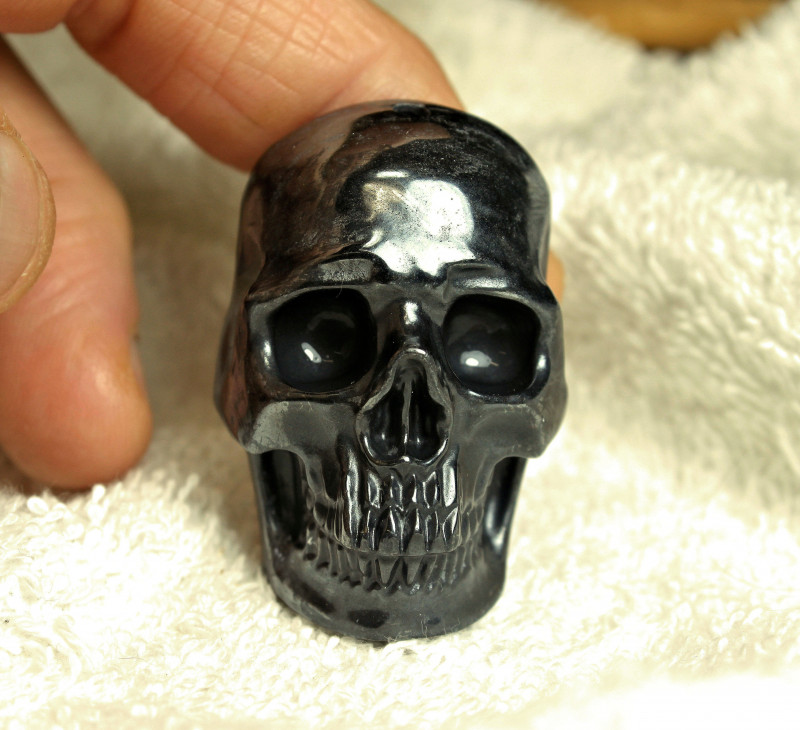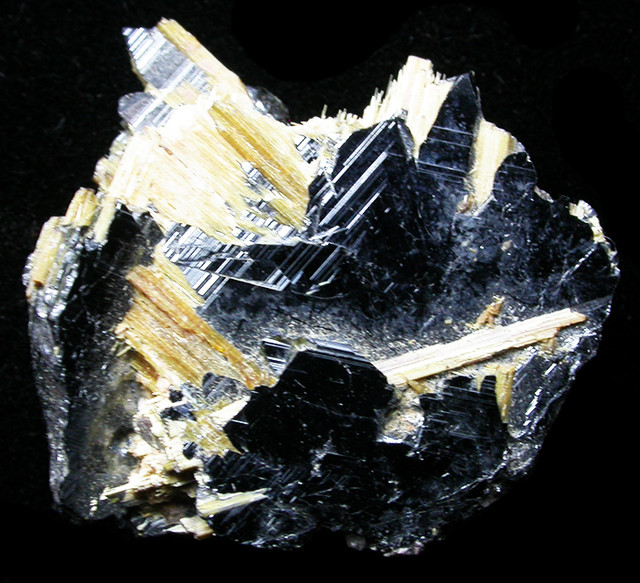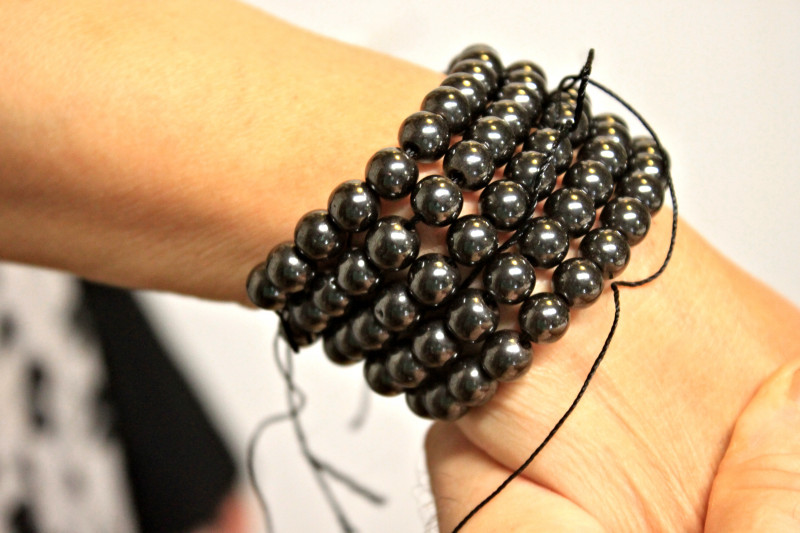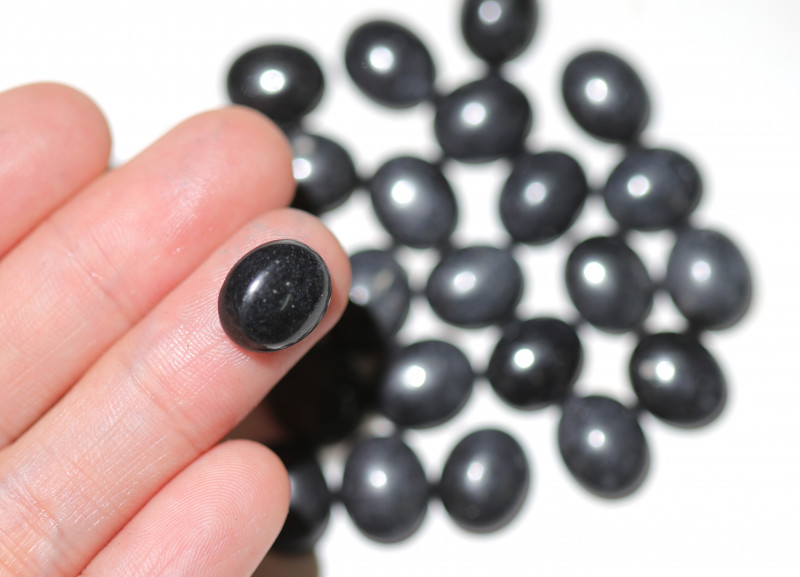
Hematite Abo: Nkyerɛase, Nneɛma ne Nea Wɔde Di Dwuma
 Sɛ wususuw aboɔden abo ho a, ebia ɛnyɛ hematite na edi kan a ɛbɛba w’adwenem. Nanso wɔ n’akyi a ɛyɛ sum no ase no, nneɛma pii a ebetumi aba wɔ hematite ɔbo no mu.
Sɛ wususuw aboɔden abo ho a, ebia ɛnyɛ hematite na edi kan a ɛbɛba w’adwenem. Nanso wɔ n’akyi a ɛyɛ sum no ase no, nneɛma pii a ebetumi aba wɔ hematite ɔbo no mu.
Hematite yɛ dade oxide ɔbo a akyi yɛ tuntum na ɛyɛ dade. Nanso, sɛ wotwitwa mu anaasɛ wobɔ mu pɛ a, wubehu ne kɔkɔɔ a ɛhyerɛn no. Sɛnea ɛyɛ adwuma wɔ mmeae pii no ma ɛyɛ ade a edi mũ ma obiara. No more racking w’amemene ma akyɛde ho adwene!
Dɛn na wɔde hematite di dwuma? Sɛ woaka kar pɛn, wode krataa a wɔde kyekyere nneɛma ho adi dwuma, anaasɛ woabue frigye pɛn a, ɛnde na wode hematite adi dwuma dedaw! Nokwarem no, sɛ woahu dɔte kɔkɔɔ wɔ baabiara a, ɛno nso fi hematite.
Wontumi nka mfaso a ɛwɔ hematite ɔbo so no ntra so. Enti dɛn nti na hematite som bo?
Yɛbɛma saa asɛmmisa no ho mmuae wɔ akwankyerɛ a ɛyɛ mmerɛw yi mu, ne biribiara a ɛsɛ sɛ wuhu fa aboɔden abo a ɛhyerɛn yi ho. Fa wo ho hyɛ mu na kɔ so kenkan ma yɛn akwankyerɛ a edi mũ a ɛfa anansesɛm mu hematite ɔbo no ho!

Dɛn ne Hematite Ɔbo?
Hematite, anaa haematite, yɛ dade oxide a ɛyɛ tuntum a wonim no sɛ ɛyɛ kɔkɔɔ kosi kɔkɔɔ-biribiri nsensanee ne dade a ɛhyerɛn.
Sɛ́ aboɔden abo no, hematite yɛ yɛn dade fibea a ɛho hia sen biara no mu biako. Sɛ́ aboɔden abo no, ɛwɔ baabiara saa ara – wɔde hematite di dwuma wɔ biribiara mu fi mmarima ne mmea agude so kosi dice a wɔasen ne ahoni so.
Wɔ nsoromma mu hwɛ mu no, hematite yɛ nsoromma mu hwɛ abo a wɔde yɛ Capricorn no mu biako. Asase so ahoɔden a ɛwɔ hematite mu no betumi ayɛ nea ɛfata wɔ Capricorn bi adwene mu. Bere koro no ara mu no, hematite betumi ahyɛ adwuma ne asetra a ɛkari pɛ yiye ho nkuran, na ɛno betumi ayɛ asɛnnennen kɛse ama asase so nsɛnkyerɛnne.
Okyinnsoromma Mars no ne hematite nso wɔ abusuabɔ. Sɛ yɛbɛhyɛ aseɛ a, hematite ne Mars nsoromma mu hwɛ su a ɛne sɛ ɛgyina pintinn na ɛyɛ den no wɔ abusuabɔ. Hematite wɔ hɔ pii mpo wɔ Mars so!
Ɛdefa sɛnea wɔtaa de di dwuma ho no, nea edi kan koraa no, hematite yɛ dade fibea titiriw. Nanso, wɔde yɛ nneɛma a ɛma nneɛma yɛ kɔla, siw mframa a ano yɛ den ano, na wɔde ma po so ahyɛn gyina pintinn mpo!
Enti, dɛn na ɛma hematite nya tumi ahorow yi? Ne nyinaa ba fam wɔ ɔbo no nnuru su a ɛyɛ anigye no so.
Hematite Nkyerɛkyerɛmu ne Ne Su
Sɛ wofa hematite ɔbo bi a, ebia ade a edi kan a wubehu ne sɛnea emu yɛ duru no. Enti, dɛn nti na hematite mu yɛ duru saa? Wiɛ, ɛyɛ den! Nokwarem no, hematite wɔ density a ɛkorɔn 50% sen aboɔden abo dodow no ara.
Dɛn na ɛwɔ mu a ɛregye saa beae no nyinaa? Dodow no ara yɛ dade ne oxygen. Wɔ ne su a ɛho tew sen biara mu no, hematite yɛ dade 70% ne oxygen 30%.
Wɔ Mohs nsenia a ɛfa mineral hardness ho no , hematite di kan wɔ 5 kosi 6.5 a ɛyɛ mfinimfini. Ɛno kyerɛ sɛ ɛwɔ ahoɔden a ɛtra hɔ kyɛ te sɛ sẽ mu aduru, ahwehwɛ, anaa titanium.
Hematite no ho nsɛm a wɔahyehyɛ no nyinaa ni:
Nnuru a wɔde yɛ nnuru : dade oxide
Mohs nsenia : 5-6.5
Kɔla : dwetɛ-akuturuku, tuntum, kɔkɔɔ-biribiri, kɔkɔɔ
Crystal nhyehyɛe : trigonal (sub-system of hexagonal) .
Luster : ɛsono nea ɛwɔ submetallic so kosi metallic so kosi dull so
Transparency : ɛnyɛ nea ɛda adi pefee
Nneɛma a ɛma nneɛma yɛ mmerɛw : 2.94-3.22
Nneɛma a ɛyɛ den : 5.3
Cleavage : biara nni hɔ
Streak : kɔkɔɔ kosi kɔkɔɔ-biribiri
Esiane sɛ hematite yɛ soronko koraa nti, ebia woresusuw ho sɛ: so hematite yɛ ɔbo a ɛsom bo? Ɛnyɛ pɛpɛɛpɛ, efisɛ abo a ɛsom bo a wɔde di dwuma wɔ amanne kwan so nkutoo ne daimond, ruby, safir, ne emerald. Nanso, hematite yɛ aboɔden abo a ɛsom bo fã bi .

Wɔ nnuru a wɔde yɛ no akyi no, hematite su afoforo bɛn na ɛho hia sɛ yehu?
Hematite Abo Aboɔden abo Nneɛma a Ɛwɔ Hɔ
Yɛaka nea enti a hematite ho hia kɛse ma nnwuma pii ho asɛm, nanso hematite agude nso ɛ? Yɛakata wo so wɔ hɔ, nso!
Afei, yɛbɛka nneɛma a ɛho hia a ɛsɛ sɛ yɛhwehwɛ mu bere a yɛretɔ hematite abo no ho asɛm.
Twa
Sɛ worehwehwɛ hematite a, worenhu asinasin a ɛwɔ afã horow pii te sɛ nea wubehu wɔ ahwehwɛ afoforo ho no. Mmom no, wɔtaa twitwa hematite ma ɛyɛ cabochons, nwene, anaa nhwiren. Aboɔden abo no ankasa yɛ den nanso ɛyɛ mmerɛw sen dade, na ɛma ɛyɛ mmerɛw sɛ wɔbɛyɛ no asinasin a ɛyɛ nwonwa.
Nanso, eyi nkyerɛ sɛ worenhu hematite agude. Wɔ asinasin a ɛwɔ afã horow a ɛntaa nsi no fam no, agudeyɛfo taa twitwa kurukuruwa, pear, anaa kurukuruwa. Wobetumi de eyinom ayɛ pendants anaa asomuade.
Hematite nhwiren abu so kɛse mpo. Wɔde hama abɔ saa nhwiren yi abɔ nkapo ne kɔnmuade fɛfɛ. Hematite nkaa yɛ nea wɔn a wɔpɛ sɛ wɔde hematite mfaso horow a ɛwɔ ahobammɔ ne asase a wɔde si fam so di dwuma bere a wɔrekɔ no ani gye ho.
Wɔ saa kwan koro no ara so no, wɔn a wɔyɛ Feng Shui no de hematite a wɔasen di dwuma de ma wɔn chi ahoɔden yɛ kɛse. Saa nsusuwso ahorow yi taa yɛ hematite ahoni te sɛ Buddha a ɔreserew anaa ɔsoro mmoa.

Seesei a yɛde hematite a wɔatwitwa asi hɔ no, momma yɛnkɔ kɔla so.
Ahosuo
Hematite ɔbo no fi awosu mu nyin wɔ ahorow kakraa bi mu, a asaabo mu aboɔden abo, martite, dade rose, ne specularite ka ho. Bere a eyinom mu biara kura n’ankasa kɔla soronko no, asaawa a ɛka bom no yɛ kɔkɔɔ tuntum a ɛyɛ nsensanee.
Ɛwom sɛ hematite sunsuma a ɛyɛ kɔkɔɔ no yɛ ade titiriw de, nanso bere a wɔde powder ayɛ anaasɛ wɔatwitwa no nketenkete nkutoo na wuhu saa kɔla yi. Nea ɛnte sɛ ahwehwɛ kɔkɔɔ afoforo te sɛ garnet anaa carnelian no, hematite wɔ kɔkɔɔ a ɛyɛ mum a efi dade a ɛma ɛyɛ hyew no mu ma ɛbɛyɛ nkannare.
Sɛ yɛreka muted ho asɛm a, momma yenhuruw nkɔ pefeeyɛ mu.
Ɛda adi pefee
Ade biako a eye sen biara wɔ aboɔden abo a wɔhyɛ ho ne sɛnea ɛhyerɛn wɔ hann no mu. Abo bi da hann adi sen afoforo, na eyi na ɛma hann no mu da hɔ.
Aboɔden aboɔ a emu da hɔ no gyina ɔbo bi a ɛda adi pefee ne nea ɛka ho so . Nneɛma kakraa bi a wɔde ka ho no kyerɛ sɛ emu da hɔ yiye, na enti, mpɛn pii no, ɛsom bo a ɛkorɔn.
Sɛ ɔbo bi fi awosu mu yɛ nea ɛnyɛ hann a, sɛnea wɔde ma emu da hɔ no yɛ mmerɛw: Opaque (O). Hematite hyɛ saa kuw yi ase efisɛ hann ntwa mu. Nanso, ɛda hann adi wɔ dade hyerɛn a ɛyɛ nwonwa mu.
Esiane sɛ hematite nni sɛnea ɛda adi pefee nti, ne bo a ɛsom no gyina sɛnea nhwɛsode no kɛse te so kɛse. Na ɛno de yɛn kɔ yɛn aboɔden abo nneɛma a etwa to no mu pɛɛ.
Carat Mu duru
Sɛ wotu hematites a, epue yɛ ahwehwɛ akɛse. Esiane sɛ ɛyɛ den na ɛnyɛ hann nti, ɛkame ayɛ sɛ wobetumi atwitwa hematite no so ayɛ no carat mu duru biara.
Hematite pii no kyerɛ sɛ abo a emu duru yɛ carat kɛse no bo yɛ den sen aboɔden abo afoforo.
Saa agyapade yi nyinaa na ɛka bo a aboɔden abo bi bo wɔ gua so ho. Nanso onipa biara tumi hu mfaso ahorow wɔ ɔbo koro no ara so. Momma yɛnhwɛ sɛnea akuw ahorow bere tenten buu hematite sɛ ɛsom bo no.

Hematite Abakɔsɛm
Hematite adi dwuma titiriw wɔ abakɔsɛm nyinaa mu. Efi abodan a na ɛwɔ hɔ ansa na abakɔsɛm reba so kosi akodi mmeae so no, ɛkame ayɛ sɛ aboɔden abo a ɛhyerɛn yi aka adesamma nnipa biara.
Hematite abakɔsɛm fi ase wɔ Abo Mmere no mu nyinaa, no pun intended. Ɔbo no kɔla kɔkɔɔ ne sɛnea ɛyɛ mmerɛw no maa ɛbɛyɛɛ nnwinnade a edi kan a wɔde kyerɛw nneɛma a onipa nim no mu biako. Tetefo nneɛma ho animdefo huu hematite sɛ chalk kɔkɔɔ--a wɔsan frɛ no sanguine--wɔ Pinnacle Point, South Africa fã bi a wosusuw sɛ nnipa nkwa fii ase.
Akyiri yi wɔ Tete Roma no, wɔde hematite dii dwuma sɛ agude a agye din, afie asiesie, ne ɔko mu. Ná Romafo bu hematite sɛ ɔkwan a wɔfa so bɔ wɔn ho ban fi asiane ho ne tete ade a ɛne #badvibes yɛ pɛ. Na ɛnyɛ wɔn nkutoo na wɔyɛɛ saa.
Nnipa pii de hematite tumi a ɛbɔ wɔn ho ban no dii dwuma wɔ bere nyinaa mu. Ná Amerikafo Ankasa hyɛ hematite sɛ ɔko mu mfonini de hwɛ hu sɛ wɔbɛbɔ wɔn ho ban na wɔabɔ wɔn atamfo hu. Misrifo no siee hematite powder wɔ wɔn faraofo adamoa mu, na ɛda adi kɛse sɛ ɛbɛbɔ nkae a ɛsom bo no ho ban afi adwowtwafo ho.
Bere a akyinnye biara nni ho sɛ na tete anibuei ahorow no de hematite yɛɛ nneɛma ho nneɛma na wɔde siesiee no, annye din sɛ agude kosii Victoria bere so. Mprempren, wɔde hematite yɛ aburow a ɛyɛ fɛ a wɔfrɛ no rouge, aduru a wɔde twa dade na wɔde yɛ no fɛfɛɛfɛ.
Sɛ woyɛ mfoniniyɛfo a, ebia woahyia mfonini ahorow a wɔde “ochre-yellow” ayɛ. Nea ebia wunnim ne sɛ ochre yɛ dɔte a wɔde ayɛ asase a wɔtaa de hematite yɛ kɔla. Sɛ hematite a nsu nni mu a, wunya ochre kɔkɔɔ, nanso sɛ hematite a nsu wom a, wunya ochre kɔkɔɔ.
Sɛnea wubetumi ahu no, hematite atra Asase so akyɛ sen obiara a ɔte ase nnɛ. Enti, ɛyɛɛ dɛn na ɛbae?
Hematite Abo Mfiase ne Nea Efi Hɔ
Hematite wɔ abotan ne aboɔden abo ahorow nyinaa mu: abotan a ogya wom, abotan a ɛsakra, nsu a ɛtɔ gu fam, ne abotan a ɛyɛ hyew.
Nanso mpɛn pii no, wubehu hematite wɔ nsu a ɛtɔ gu fam mu, a ɛwɔ magnetite ne quartz mineral chert ntam. Wɔfrɛ saa nneɛma a ɛwɔ ntoatoaso yi sɛ banded iron formations, anaa BIFs.
Enti, hematite ahorow bɛn na ɛwɔ abɔde mu?
Hematite Ahorow a Agye Din
Abɔde mu hematite yɛ ɔbo a ɛwɔ anim pii. Hematite abo gyina nneɛma a atwa yɛn ho ahyia te sɛ nsu anaa asase so yɛ nsusuwii ahorow a ɛyɛ anigye.
Nsusuwii biako a wobɛtaa ahu ne ɔbopon no. Wɔfrɛ saa ahorow yi specularite na ɛyɛ hematite a ɛte sɛ ahwehwɛ a ɛyɛ mprɛte a wɔaboaboa ano. Mprɛte no da hematite dade a ɛhyerɛn adi bere a wodannan ɔbopon no.
Ahorow foforo a ɛyɛ anigye ne asaabo mu aduru. Wɔtoo hematite ɔbo yi din esiane ne soro a ɛyɛ kurukuruwa a ɛte sɛ asaabo nti. Mpɛn pii no, n’anim yɛ kɔkɔɔ, nanso ɛda so ara da hematite agyiraehyɛde a ɛyɛ dade a ɛhyerɛn adi.
Sɛ asaabo mu aduru no nyɛ wo dea a, ebia w’ani begye dade rose ahorow no ho. Iron rose nyaa ne din esiane nhwiren a enyin kɔ mu bere a wɔreyɛ no nti. Nhwiren a ɛkata so a ɛtoatoa so no yɛ nea ɛkyere adwene araa ma, ebia wo werɛ befi sɛ dade rose no ankasa nyin saa.

Ɛhe na wohu hematite?
Hematite a Wɔtu Fam Nneɛma a Wɔde Sie
Nneɛma pii a wɔde tu fam no fi Europa, titiriw England ne Italy. Mmeae afoforo a ɛdɔɔso wɔ wiase nyinaa ne:
Brazil
South Africa
Canada
China
Russia
India
Australia
USA
Ebia woate Atare Kɛse no ho asɛm pɛn. Nanso so wunim sɛ ɛhɔ na hematite a wotu wɔ U.S. no mu dodow no ara fi? Nokwarem no, Ɔtare Superior ne hematite fibea titiriw wɔ U.S
Bere a aman bɛyɛ 50 na ɛwɔ hematite a ɛwɔ hɔ no, Australia ne Brazil ne aman a wɔyɛ no kɛse. Wɔ afe 2020 mu no, aman abien yi yɛɛ metric tɔn ɔpepem 1,300!
Hematite a wotu no mu dodow no ara kɔ dade a wɔbɔ, nanso ɛwɔ metaphysical mfaso pii, nso. Sɛ ɛba hematite ntease ahorow so a, honhom mu sɛnkyerɛnnede ahorow bɛn na yebetumi ahu?
Hematite Abo Nkyerɛase
Edin hematite no gyinaa ne nsaano nkyerɛwee kɔkɔɔ so no fi Hela asɛmfua hema anaa haima , a ɛkyerɛ mogya no mu. Engiresifo din a wɔde frɛɛ ɔbo no fi Tete Hela kasasin bi a ɛware, haimatitēs lithos , a ɛkyerɛ “ɔbo kɔkɔɔ a mogya wom.”
Ɛsɛ sɛ yɛhyɛ no nsow sɛ mogya mu abo, silica tuntum bi a ɛwɔ nsensanee kɔkɔɔ no yɛ aboɔden abo soronko.
Nanso, fekubɔ a hematite ne mogya wɔ no kɔ akyiri sen ne kɔla. Ɛtɔ mmere bi a, na wɔde siw mogya a ɛyera dodo ano, titiriw mmaa a wɔrewo.
Fekubɔ a ɛtaa ba ma hematite a mogya nka ho ne nkonyaayi. Hematite honhom mu ntease bata tumi a etumi kari pɛ wɔ honhom ne honam fam nneɛma mu no ho. Wɔ ankorankoro fam no, ɛno betumi ayɛ te sɛ nea worebɔ wo honam nipadua ho ban afi tumi ahorow a ɛboro nnipa de so ho.
Wɔfrɛ Hematite “Adwene mu Nkonimdi Ɔbo” esiane tumi a wosusuw sɛ ɛde pefeeyɛ ne nyansa brɛ obiara a ɔhyɛ no nti.
Seesei mo nyinaa akɔfa hematite honhom fam ntease no ho. Nanso, wɔ ayaresa ho no, dɛn na hematite ɔbo no ye ma? Na bere a ebetumi ama honhom no aduan no, so hematite ye ma wo nipadua?

Hematite Honhom ne Ayaresa Su ahorow
Ebia ɛnyɛ nwonwa sɛ mfaso a ɛwɔ hematite ɔbo so ma nipadua mu ayaresa no bata mogya ho. Hematite betumi aboa ma mogya no akɔ so yiye, na ama brayɛ mu ɛyaw ne nan a ɛyɛ mmerɛw no ano abrɛ ase. Iron a ɛdɔɔso wɔ hematite mu no kyerɛ sɛ ebetumi aboa ma wɔatwe iron, titiriw ma wɔn a mogya atɔ wɔn anaasɛ wodi afifide/vegan aduan akyi.
Hematite abo betumi ayɛ adwuma sɛ ɔwɛmfo a ɔyɛ den ama nkate mu ayaresa, abɔ wo ho ban afi asiane ho na ama woakɔ fam akodu mprempren. So woanya nsusuwii pii a ɛrekɔ so a wuntumi nsusuw nneɛma ho yiye pɛn? Hematite betumi aboa! Nea ɛka ne mfinimfini su ho no, hematite betumi ayɛ adwinnade a tumi wom a ɛbɛma emu ada hɔ na ayɛ nea ɛyɛ den.
Na honhom mu ayaresa nso ɛ? Hematite chakra no ne ntini chakra, anaasɛ base chakra, a ɛwɔ akyi berɛmo no ase no hyia. Saa beae yi kura yɛn awosu atitiriw ne abusuabɔ a ɛda yɛne Asase ntam.
Sɛ́ nnipa no, yɛwɔ ahiade titiriw sɛ yɛbɛte ahobammɔ ne ahobammɔ nka. Sɛ wɔsiw ntini chakra no a, yebetumi ate abasamtu ne dadwen nka. Hematite bue, na ɛma yenya fapem a yɛde benyin na ɛma yetumi hu yɛn atirimpɔw ankasa wɔ wiase.
Sɛ eyi te sɛ nea ɛyɛ dɛ a, ebia woresusuw ho sɛ: So wubetumi ahyɛ hematite da biara da? Mmuae no begyina w’ankasa w’ahoɔden so.
Hematite ahoɔden betumi ayɛ nea ɛboro so na ama nnipa binom ate nka sɛ wɔayɛ duru a wonnye wɔn ahome mfi ho. Nnipa afoforo nso yɛ papa sɛ wɔhyɛ da mũ nyinaa. Yɛn afotu a eye sen biara ne sɛ wubenya wo nkate mu ahotoso na kwati sɛ wobɛhyɛ akɔda.
Sɛnea ɛbɛyɛ a wobɛhwɛ ahu sɛ wowɔ ɔbo a wode bɛto fam bere nyinaa no, ɛho hia sɛ wuhu sɛnea wobɛhohoro wo hematite no ho na woatew ho.

Hematite Hwɛ ne Nsiesiei
Ahwehwɛ a ɛsa yare no yɛ adwuma denam ahoɔden pa anaa ahoɔden a enye a ɛtwetwe so. Saa ahoɔden no nyinaa betumi asiw kwan, enti ɛsɛ sɛ wɔtew ahwehwɛ ahorow bi ho na amma eyi asiw ano.
So ɛho hia sɛ wɔtew hematite ho? Yɛhyɛ nyansa sɛ yɛ saa! Akwan a yɛpɛ paa ni:
Fa brɔs a ɛyɛ mmerɛw na ɛyɛ nwunu petepete so na ama ahoɔden bɔne a ayɛ kɛse no afi hɔ.
Fa wo hematite bo no hyɛ po mu nkyene kuruwa mu anadwo biako na ama ɛho tew na ɛho tew.
Fa ɔbo no charge denam fa a wode bɛto ahwehwɛ a wɔde quartz ayɛ so (sɛ nhwɛso no, amethyst, citrine, aventurine).
Bere a hematite abo no mu yɛ den sen aboɔden abo bi no, ɛda so ara yɛ mmerɛw. Sɛnea ɛbɛyɛ a worensɛe ade no, kwati:
Nneɛma a wɔde tew nneɛma ho a wɔde ultrasonic yɛ
Steam a wɔde tew nneɛma ho
Nnuru a wɔde yɛ ofie te sɛ ammonia ne acid
Esiane sɛ hematite no yɛ mmerɛw nti, yɛhyɛ nyansa sɛ fa to nkyɛn fi nsu ho sɛnea wubetumi biara.
Mpɛn ahe na ɛsɛ sɛ wuwie saa anammɔn yi? Yɛhyɛ nyansa sɛ tew hematite ho pɛnkoro ɔsram biara. Ɛdefa ahotew ho no, anyɛ yiye koraa no, di yɛn afotu a ɛwɔ atifi hɔ no akyi pɛnkoro ɔsram biara anaa mpɛn pii, a egyina dodow a wode wo bo no bedi dwuma so.
Sɛ woasiesie wo ho sɛ wubefi ase ahwehwɛ hematite a, kɔ so kenkan yɛn bo a wɔakyekyɛ no.

Hematite Bo ne Ne Bo
Hematite bo yɛ ahe? Sɛ yɛka ne nyinaa bom a, hematite yɛ ɔbo a ne bo yɛ den esiane sɛnea ɛdɔɔso nti.
Sɛ wɔbɔ ka kɛse a, hematite nhwɛsode ahorow no fi dɔla 0.05 kosi dɔla 0.25 wɔ carat biara mu. Hematite akuwakuw a ɛte saa no taa yɛ akɛse--efi carat 75 kosi ɛkame ayɛ sɛ carat 600. Ɛno mpo no, wubetumi anya hematite nhwɛsode kɛse bi a ne bo nnu dɔla 30.
Hematite bo a ɛyɛ nwonwa no kɔ soro kakra, na sɛ wɔkyekyem pɛpɛɛpɛ a, ne bo bɛyɛ dɔla 3 wɔ carat biara mu.
Hematite a wɔde nsa ayɛ no som bo kɛse, nso. Hematite nkuruwankuruwa dodow no ara yɛ asinasin nketenkete--wɔn nsateakwaa 2 ase. Eyinom bo betumi ayɛ bɛyɛ dɔla 8 wɔ carat biako anaa nea ɛboro saa mu, a egyina sɛnea adwini no mu nsɛm kɔ akyiri so. Nneɛma a wɔasen a ɛsõ sen nsateakwaa 5 no bo yɛ den kɛse.
Asinasin a wubehu sɛ wɔtɔn sɛ hematite no pii yɛ hematine ankasa. Hematine yɛ ade a nnipa ayɛ a ɛkame ayɛ sɛ ɛte sɛ hematite.
Wobɛyɛ dɛn ahu nsonsonoe a ɛda hematite ne hematine ntam? Hematine yɛ magnetic, bere a hematite nyɛ saa. Ɔkwan a ɛyɛ mmerɛw a wobɛfa so ahwɛ sɛ magnetism wɔ hɔ ne sɛ wode biribi a ɛyɛ dade te sɛ safe anaa bobby pin bedi dwuma.
Worehwehwɛ Asomdwoe ne Ahobammɔ?
Ɛno na ɛkyekyere yɛn akwankyerɛ a ɛkɔ akyiri a ɛfa hematite ɔbo no ho no! Wubetumi ahu afei nea enti a saa aboɔden abo yi boro nea aniwa hyia so koraa no.
Sɛ́ ɔbo a ɛsa yare no, hematite ma yenya awerɛkyekye ne ahobammɔ a yɛn nyinaa betumi de adi dwuma kɛse. Sɛ yɛde ne honhom fam nneɛma to nkyɛn mpo a, ɛyɛ ade a edi mũ a wɔde siesie fie a wɔde bɛka dan anaa atade biara ho.
Akyinnye biara nni ho sɛ efi sɛnea na ɛwɔ hɔ wɔ adesamma mfiase so kosi sɛnea wɔde di dwuma ahorow a ɛso bi nni so no, akyinnye biara nni ho sɛ hematite yɛ yɛn wiase no fã a ɛsom bo kɛse.
Sɛ woahwehwɛ ɔbo a wode bɛto fam a ɛne biribiara ne biribiara bɛyɛ pɛ a, hwehwɛ yɛn hematite abo no mu nnɛ !
搜尋Gemstone Encyclopedia
相關拍賣
相關文章
Obiara wɔ aboɔden abo a ɛne ne nsoromma agyiraehyɛde hyia. Wɔsan frɛ eyinom sɛ wo Nsoromma Abo. Sua pii fa saa abo yi ho na hwehwɛ nea wo Nsoromma Abo no yɛ.
10th May 2018
Mfiase no na wɔde Awo Abo anaa aboɔden abo no bata nsoromma mu hwɛ anaa ɔsram a ankorankoro bi awo ho. Hwehwɛ nea wo bo no yɛ na hwɛ abo a yɛwɔ sɛ yɛtɔn no
8th Feb 2021
Nnwinnade pii wɔ gua so a wɔde sɔ ɔbo a ɛsom bo hwɛ, nanso dɛn ne nnwinnade atitiriw a wɔhwehwɛ ma nhwehwɛmu a ɛnyɛ den. Momma yɛnhwɛ nnwinnade anan a wɔde sɔ aboɔden abo hwɛ.
4th Mar 2020
最新的文章
Nnua a wɔde asonse a wɔasen a wɔsan frɛ no nhabannuru asonse no yɛ abɔde mu ade a wɔde si asono asonse ananmu, na wotwa fi Amerika Kesee Fam phytelephas nnuadewa mu nnuadewa mu wɔ abrabɔ pa mu. Sua mmɛw asonse ho ade nyinaa wɔ akwankyerɛ yi mu!
15th Jan 2026
Chrysanthemum nhwiren abo yɛ abɔde mu anwonwade a ɛwɔ calcite, celestite, anaa andalusite nhwiren fitaa bi a wɔde asisi limestone tuntum anaa atɛkyɛ abo so.
13th Jan 2026
Rainbow lattice sunstone yɛ feldspar ahorow a ɛwɔ optical nsunsuanso abiɛsa fɛfɛ a efi nneɛma ahorow a wɔde ka ho a ɛwɔ hɔ no mu ba. Ɛyɛ ogya kɔla display ne lattice nsusuwso ma ɛyɛ coletor abohene a wɔntaa nhu!
12th Jan 2026
文章類別
How To's is where you will find helpful articles from gem Rock Auctions on how to cut gemstones, select gemstones and buy gemstones.
9文章





